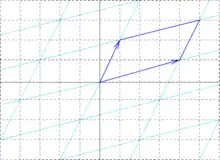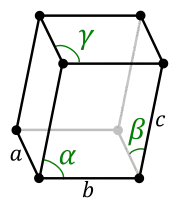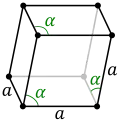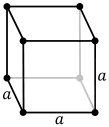Primitive cell
In geometry, biology, mineralogy, and solid state physics, a primitive cell is a unit cell corresponding to a single lattice point of a structure with discrete translational symmetry. The concept is used particularly in describing crystal structure in two and three dimensions, though it makes sense in all dimensions. A lattice can be characterized by the geometry of its primitive cell.
In some cases, the full symmetry of a crystal structure is not obvious from the primitive unit cell, in which cases a conventional cell may be used. A conventional cell (which may or may not be primitive) is the smallest unit cell whose axes follow the symmetry axes of the crystal structure. The volume of the conventional cell is always an integer multiple (typically 1, 2, 3, or 4) of the primitive cell volume.[1]
The primitive cell is a primitive place. A primitive unit is a section of the tiling (usually a parallelogram or a set of neighboring tiles) that generates the whole tiling using only translations, and is as small as possible.
The primitive cell is a fundamental domain with respect to translational symmetry only. In the case of additional symmetries a fundamental domain is smaller.
Overview
A crystal can be categorized by its lattice and the atoms that lie in a primitive cell (the basis). A cell will fill all the lattice space without leaving gaps by repetition of crystal translation operations.
By definition, a primitive cell must contain exactly one and only one lattice point. For unit cells generally, lattice points that are shared by n cells are counted as 1/n of the lattice points contained in each of those cells; so for example a primitive unit cell in three dimensions which has lattice points only at its eight vertices is considered to contain 1/8 of each of them.[2] An alternative conceptualization is to consistently pick only one of the n lattice points to belong to the given unit cell (so the other 1-n lattice points belong to adjacent unit cells).
Two dimensions

A 2-dimensional primitive cell is a parallelogram, which in special cases may have orthogonal angles, or equal lengths, or both.
| Conventional primitive cells | Non-conventional primitive cells | |||
|---|---|---|---|---|
 |
 |
 |
 | |
| Shape name | Parallelogram | Rectangle | Square | Rhombus |
| Bravais lattice | Primitive Monoclinic | Primitive Orthorhombic | Primitive Tetragonal | Centered Orthorhombic |
Three dimensions

The primitive translation vectors a→1, a→2, a→3 span a lattice cell of smallest volume for a particular three-dimensional lattice, and are used to define a crystal translation vector
where u1, u2, u3 are integers, translation by which leaves the lattice invariant.[note 1] That is, for a point in the lattice r, the arrangement of points appears the same from r′ = r + T→ as from r.[3]
Since the primitive cell is defined by the primitive axes (vectors) a→1, a→2, a→3, the volume Vp of the primitive cell is given by the parallelepiped from the above axes as
For any 3-dimensional lattice, you can find primitive cells which are parallelepipeds, which in special cases may have orthogonal angles, or equal lengths, or both. While not mathematically required, by convention, one usually defines the parallelepiped primitive cell so that there is a lattice point on each corner. When the lattice points are on the corner, each lattice point is shared by eight different primitive cells, so each lattice point will contribute only 1/8 of a lattice point to each of those cells. However, there are eight corners, so there is still a total of one lattice point per cell, as required by definition. Some of the fourteen three-dimensional Bravais lattices are represented using such parallelepiped primitive cells, as shown below.
| Conventional primitive cell |  |
 |
 |
 |
 |
 |
|---|---|---|---|---|---|---|
| Shape name | Parallelepiped | Oblique rectangular prism | Rectangular cuboid | Square cuboid | Trigonal trapezohedron | Cube |
| Bravais lattice | Primitive Triclinic | Primitive Monoclinic | Primitive Orthorhombic | Primitive Tetragonal | Primitive Rhombohedral | Primitive Cubic |
The other Bravais lattices also have primitive cells in the shape of a parallelepiped, but in order to allow easy discrimination on the basis of symmetry, they are represented by conventional cells which contain more than one lattice point.
| Primitive cell |  |
 |
|---|---|---|
| Shape name | Oblique rhombic prism | Right rhombic prism |
| Conventional cell |  |
 |
| Bravais lattice | Base-centered Monoclinic | Base-centered Orthorhombic |
Wigner–Seitz cell
An alternative to the unit cell, for every Bravais lattice there is another kind of primitive cell called the Wigner–Seitz cell. In the Wigner–Seitz cell, the lattice point is at the center of the cell, and for most Bravais lattices, the shape is not a parallelogram or parallelepiped. This is a type of Voronoi cell. The Wigner–Seitz cell of the reciprocal lattice in momentum space is called the Brillouin zone.
Notes
-
In n dimensions the crystal translation vector would be
References
- Ashcroft, Neil W. (1976). Solid State Physics. W. B. Saunders Company. p. 73. ISBN 0-03-083993-9.
- "DoITPoMS – TLP Library Crystallography – Unit Cell". Online Materials Science Learning Resources: DoITPoMS. University of Cambridge. Retrieved 21 February 2015.
- Kittel, Charles. Introduction to Solid State Physics (8 ed.). Wiley. p. 4. ISBN 978-0-471-41526-8.
